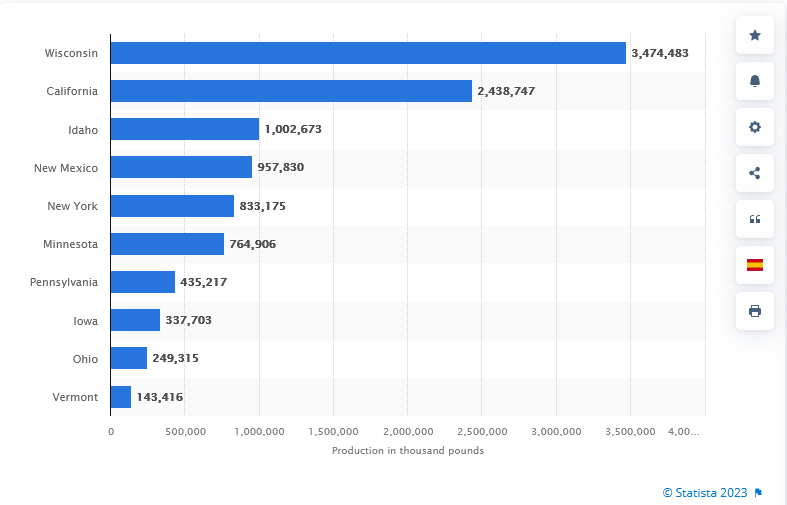Everyone knows Wisconsin leads the nation in cheese production (see graphic), but did you know that Wisconsin’s more than 1.2 billion dairy cows produced more than three billion gallons of milk last year?
Leading U.S. states in total cheese production in 2021 (in 1,000 pounds)

Here are some other facts and figures about Wisconsin:
Geography:
Wisconsin covers an area of 65,496 square miles, making it the 23rd largest state in the union, just below Florida but just above Illinois (ha!). Its most striking geographical feature is its proximity to the Great Lakes. According to the Wisconsin Department of Natural Resources (DNR),
Wisconsin is bordered to the north and east by two of the world’s largest lakes. To the north, Lake Superior forms the largest expanse of freshwater in the world. To the east lies Lake Michigan, the largest freshwater lake entirely within the United States. Lake Michigan and Superior along with Huron, Erie and Ontario and their tributaries form the largest freshwater ecosystem on earth. Their watershed covers parts of eight states and two Canadian provinces. Wisconsin has more than 800 miles of Great Lakes shoreline and more than 20% of the state’s land area lies within the Great Lakes basin.
Wisconsin is in the path of the Mississippi Flyway, a “river of birds” flowing from the headwaters of the Mississippi to the Gulf of Mexico. The Audubon Society reports that “more than 325 bird species make the round-trip each year along the Mississippi Flyway, from their breeding grounds in Canada and the northern United States to their wintering grounds along the Gulf of Mexico and in Central and South America.” Wisconsinites get to see them all.
Forests (or “woods” as we like to call them) are a huge presence on the Wisconsin landscape. According to the DNR,
Acreage in timberland in Wisconsin stands at over 16.4 million acres, which has remained relatively stable since 2010. These forests are becoming middle-aged with major increases in stands 80+ years old. However, acreage in very young stands has decreased in the last three decades. Most forest land is privately owned and located in northern and central parts of the state. The volume of wood is steadily increasing, with 22.2 billion cubic feet of merchantable bole volume in growing-stock trees in 2018. The species with the greatest volume are red oaks, sugar maple and red maple.
Wisconsin also has some of the most fertile farmland in the world. The state is home to some 64,100 farms on 14.2 million acres. We have about 6,000 dairy farms, more than any other state. In addition to producing so much of the country’s cheese and milk, Wisconsin ranks first in the nation for snap beans for processing, cranberries, ginseng, mink pelts, dry whey for humans, milk goats, and corn for silage.
When you see that Wisconsin has 16.4 million acres of timberland and 14.2 million acres of farmland, you understand why our countryside looks different from any other state. Everywhere you look you see farmland and woodland. Trees form the background of and frame fields and farm buildings, creating a checkerboard pattern that is never boring or monotonous. The woods break up the scenery, provide habitat for birds, deer, and other wildlife, and say you are never far from a place to fish, hunt, or just enjoy a wilderness redoubt.
Population:
The 2020 U.S. Census put Wisconsin’s population at 5,893,718, a 3.6% increase since 2010. Almost six million people! The ten most populous counties in the state are:
-
- Milwaukee
- Dane
- Waukesha
- Brown
- Racine
- Outagamie
- Winnebago
- Kenosha
- Rock
- Marathon
The ten biggest cities in the state are:
-
- Milwaukee
- Madison
- Green Bay
- Kenosha
- Racine
- Appleton
- Waukesha
- Eau Claire
- Oshkosh
- Janesville
Economy:
According to the St. Louis Fed, Wisconsin’s annual gross state product in 2021 was $368 billion. Wisconsin has just over 3 million people in its workforce. Median household income (in 2021 dollars) for 2017–2021 was $67,080. Per-capita income in the past 12 months (in 2021 dollars) for 2017–2021 was $36,754. The state’s poverty rate was 10.8%, and the unemployment rate in January 2023 was only 2.9%.
The U.S. Census Bureau reports the median value of owner-occupied housing units in Wisconsin in 2017–2021 was $200,400. Ninety-three percent of individuals age 25 or older have high school degrees and 31.5% have college degrees.
The five sectors of the economy reporting the largest number of employees are as follows:
551,000 Trade, Transportation, and Utilities
481,000 Manufacturing
464,000 Education and Health Services
399,000 Government
326,000 Professional and Business Services
Where do all the jobs come from? The Great Lakes, along with thousands of smaller lakes and hundreds of miles of rivers, support a recreational boating industry that generates approximately $9.4 billion a year in economic activity. More than $7 billion worth of cargo passes through Wisconsin ports each year.
Agriculture is a big economic driver contributing $104.8 billion annually to our state’s economy. Food processing activity contributes $82.7 billion to industrial sales. Wisconsin agriculture accounts for 435,700 jobs or 11.8% of the state’s employment. On-farm production contributes 154,000 jobs while processing contributes 282,000 jobs. Wisconsin exported $4.22 billion of agricultural and food products to 142 countries in 2022.
Forestry products are another big economic engine in Wisconsin. The forest products industry in Wisconsin provides more than 61,000 direct full and part-time jobs, total industry output of $24.4 billion, and value-added of $6.9 billion. It ranks 12th in terms of the number of full-and part-time jobs, 10th in value-added, and 2nd in industry output in the state.

